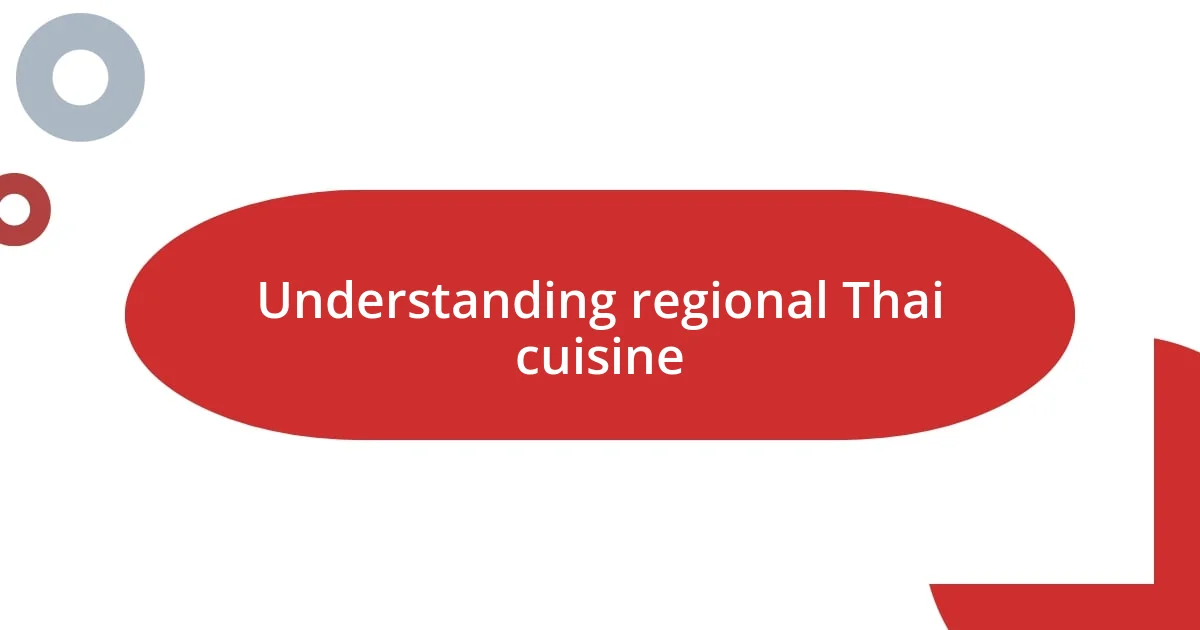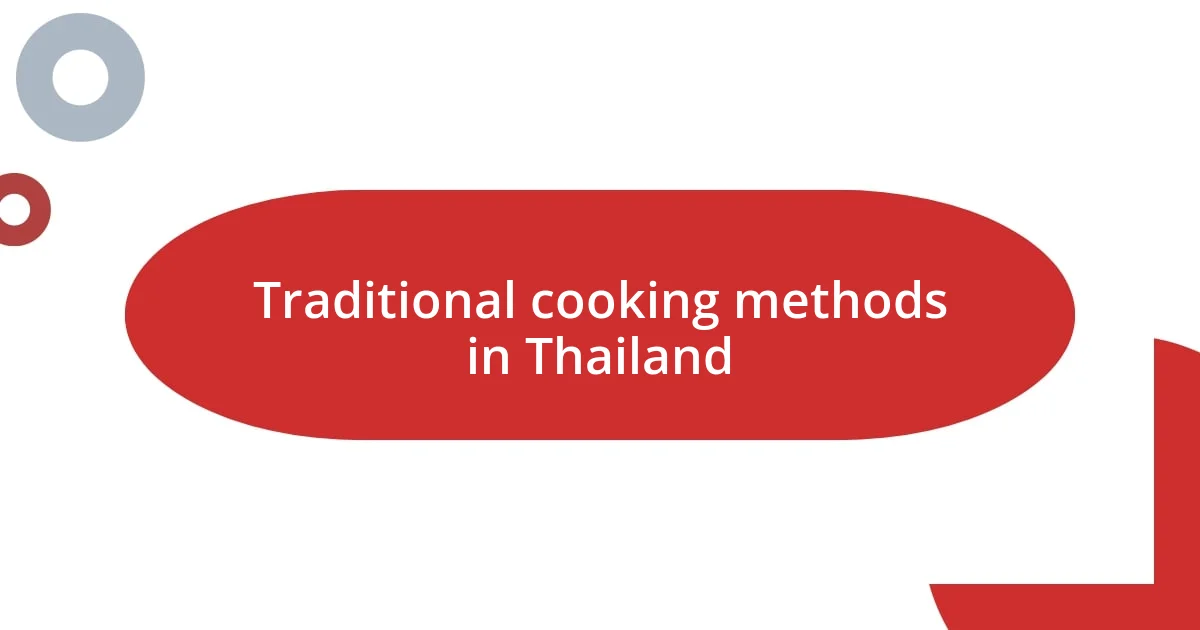Key takeaways:
- Regional Thai cuisine reflects diverse flavors and communal experiences, as seen in dishes like som tam and khao soi, which highlight local ingredients and cultural connections.
- Traditional cooking methods, such as stir-frying and steaming, preserve natural flavors and create memorable communal cooking experiences.
- Personal encounters with Thai food, like attending local festivals and participating in cooking classes, emphasize the emotional and cultural significance of shared meals and culinary traditions.

Understanding regional Thai cuisine
When I first dove into regional Thai cuisine, I was struck by how each area tells its own story through flavors and ingredients. For instance, northern Thai dishes often incorporate dried spices and herbs, which give them a rich, complex taste that’s unlike anything I’ve experienced elsewhere. It’s fascinating to consider how geography and culture shape what ultimately finds its way to the plate.
As I explored the spicy depths of Isaan cuisine, I realized that the use of sticky rice and bold spices isn’t just about sustenance; it’s about community. I can still recall my first experience sharing a platter of som tam (green papaya salad) and grilled meats with locals, surrounded by laughter and camaraderie. Isn’t it amazing how food can bridge cultural divides and create lasting bonds?
From the lush coconuts on the southern islands to the fresh seafood along the coastal regions, each flavor profile is a reflection of the landscape. I often think about how, in Southern Thailand, dishes like massaman curry evoke a harmony of sweet and savory, a blend rooted in a mixture of influences, including Malay and Indian. Exploring these regional nuances makes me wonder: how much does our own environment shape what we find delicious?

Exploring ingredients in Thai dishes
What’s intriguing is how these vibrant ingredients transform based on their use. In central Thailand, the combination of coconut milk and fresh herbs creates a velvety texture that’s utterly comforting. I can still picture my friend’s face when we first tried a red curry together; the creamy, spicy blend was enough to make us forget the heat outside. It’s not just about flavor; it’s a full experience that immerses you in the culture.
Lastly, consider the presence of fish sauce in countless Thai recipes. Its savory umami punch elevates dishes like pad thai and contributes to that signature taste we all recognize. I recall a day spent soaking up the sun, preparing a homemade version with friends; the laughter and the aroma of fish sauce sizzled in the pan made it a moment to remember. In each bite, I felt connected to the rich traditions that define Thai cooking.
| Ingredient | Region |
|---|---|
| Lemongrass | Southern Thailand |
| Coconut Milk | Central Thailand |
| Fish Sauce | National |

Traditional cooking methods in Thailand
Traditional cooking methods in Thailand are a beautiful testament to the country’s rich cultural heritage. One of the most fascinating aspects is the use of clay pots and charcoal stoves, both of which impart unique flavors that modern appliances just can’t replicate. I remember the first time I watched a street vendor skillfully stir-frying ingredients over an open flame; the smoky aroma that filled the air was absolutely intoxicating.
Additionally, the practice of boiling or steaming food, often done with bamboo baskets, highlights the emphasis on preserving natural flavors. I felt particularly drawn to this method when I visited a small village where families would gather to prepare meals together, laughing and sharing stories as they worked. This collective experience, paired with the fresh, vibrant meals that emerged from their traditional techniques, created a lasting memory that I cherish deeply.
- Main methods include:
- Stir-frying: Quick cooking over high heat to retain textures.
- Steaming: Often done in bamboo baskets to keep ingredients moist.
- Grilling: Using charcoal for an authentic smoky flavor.
- Fermenting: Preserving ingredients like fish and vegetables, contributing depth to dishes.
- Boiling: Creating rich broths that serve as the base for many soups.

Signature dishes from different regions
Stepping into the world of regional Thai dishes, I find myself captivated by the diversity that each area brings to the table. In northern Thailand, the iconic khao soi—a creamy coconut curry noodle soup topped with crispy noodles—melds flavors that transport me back to cozy nights spent seeking warmth in bustling markets. I remember the first time I savored this dish, its melding of spicy and savory dancing on my palate, making every slurp an adventure.
Venturing south, I can’t help but recall how the fiery som tam, a green papaya salad, introduced me to a world of flavors I never knew existed. The crunch of fresh vegetables and the tartness of lime combined with the heat of chilies left me exhilarated. That first bite was eye-opening; it was like being hit with a wave of heat that perfectly balanced with the sweetness and umami—each flavor pulling me deeper into Thailand’s vibrant food scene.
And then there’s the undeniable comfort of central Thailand’s pad see ew. Stir-fried flat noodles coated in a sweet soy sauce, I remember the first self-cooked version I attempted. The kitchen filled with the sound of sizzling as I tossed the noodles, with each movement igniting memories of family gatherings where this dish was always a highlight. It made me wonder: how can something so simple evoke such warmth and nostalgia? That’s the magic of signature dishes; they connect us not just to flavors, but to the very essence of home.

Personal experiences with Thai foods
One of my most memorable experiences with Thai food happened during a trip to Chiang Mai. I stumbled upon a local food festival where vendors showcased their regional specialties. The moment I tasted the fiery larb, a minced meat salad seasoned with lime and herbs, it was as if I’d been kissed awake by flavor. The warmth of that dish lingered both on my tongue and in my heart, filling me with a sense of connection to the culture that created it. Have you ever had a dish that made you feel like you were part of something bigger?
Another instance that stands out is when I learned to make tom yum goong, the famous hot and sour shrimp soup, in a cooking class near Bangkok. The teacher emphasized balancing sweet, sour, and spicy elements, which really struck a chord with me. As I tasted my creation, the complex harmony brought tears to my eyes—I realized that cooking was about more than just food; it was about crafting experiences. It’s fascinating how a simple bowl of soup can serve as a reminder of our emotions and connections, isn’t it?
Lastly, I can’t forget the time I shared a plate of pad kra pao with friends at a bustling night market. The aroma of basil and garlic wafted through the air as we packed in around a small table. Our laughter echoed as we swapped bites, the heat from the chilies mingling with our shared excitement. In that moment, I understood how food can create bonds, nurturing not just our bodies but our friendships. Doesn’t it make you think about your own shared meals and the stories they tell?















